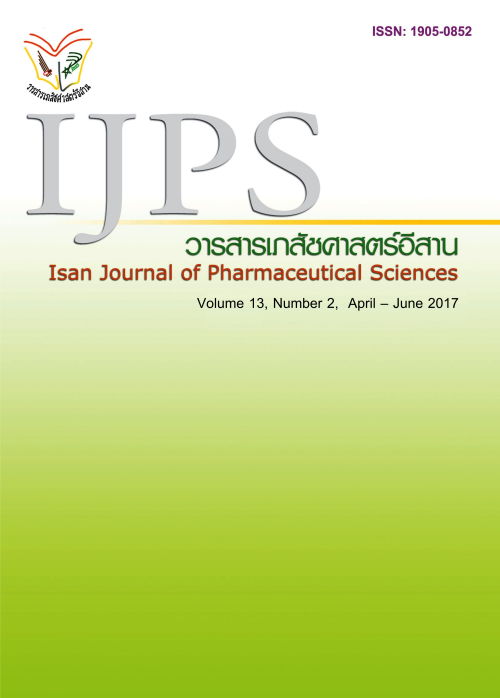Development of cosmetic product from herbals in Sripoom community in Thonburi area
Main Article Content
Abstract
Introduction: Nowadays, people are more attentive to their health. Herbal are getting attention in body about skin care. The aims of this study were to development of cosmetic product from herbal crude extract in Sripoom community. Materials and Method: The four herbal extracts were prepared by decoction and maceration by using ethanol. The antioxidant activity assays were performed using the DPPH, ABTS and FRAP assay. Selectively extract the highest antioxidant for gel formulation development. The physical and chemical stability were tested including appearance, color, odor, viscosity, pH and antioxidant activity at hot and cold temperature condition and temperature 45 ๐C. Results: The water extract from leaves of Moringa oleifera Lam. showed higher antioxidant activities was evaluated by DPPH, ABTS and FRAP. Averaged IC50, Vitamin C equivalent antioxidant capacity (VEAC) and Ferric reducing antioxidant power (FRAP value) were 99.276 ± 2.005 ppm, 2.402 ± 0.007 mM/g and 14.800 ± 0.343 mM/g as determined by the DPPH, ABTS and FRAP assays, respectively. Therefore, the development of formulated antioxidant gel from mixed leaves of Moringa oleifera Lam. water extract and the stability test. Whereas the formula mixed leaves of Moringa oleifera Lam. extract showed higher antioxidant activities (IC50 = 97.724 - 123.893 ppm) and shown good physical and chemical stable. when compared to the control formulas in 90 days. The antioxidant activity at day 90 in gel formula decrease 6.67 % compared with day 0. This cosmetic gel formula can store for one year at room temperature. Conclusion: The water extract from leaves of Moringa oleifera Lam. have efficiency in antioxidant activity and suitable for developing gel formulations in skin care product.
Article Details
In the case that some parts are used by others The author must Confirm that obtaining permission to use some of the original authors. And must attach evidence That the permission has been included
References
AmornlerdpisonD, et al. Anti-oxidant activity of Sargassum polycystumC. Agardh. J Fisheries Technology Res2006; 2(2): 96-103.
Benzie IFF. and Strain JJ. The ferric reducing ability of plasma (FRAP) as a measure of “antioxidant power” the FRAP assay. Analytical Biochemistry1996; 239: 70-76.
Charrouf Z. and Guillaume D. Phenols and polyphenols from Argania spinosa. Am. J. Food Tech2007; 2(7): 679-683.
Chumark P, Khunawat P, Sanvarinda Y, Phornchi-rasilp S, Morales NP, Phivthong-ngame L, Ratanachamnong P, Srisawatf S, Klai-upsorn S. and Pongrapeeporn G. The in vitroand ex vivoantioxidant properties, hypolipidaemic and antiatherosclerotic activities of water extract of Moringa oleiferaLam. leaves. J Ethnopharmacology2008;116(3): 439-446.
Fahey JW. Moringa oleifera: A review of the medi-cal evidence for its nutritional, therapeutic, and prophylactic properties. part 1. TFL Journal. Retrieved August 8, 2016, from http://www.tfljournal.org/images/articles/20051201124931586_3.pdf
Igbo UE, Igoli JO, Onyiriuka SO, Ejele AE, Ogukwe CE, Ayuk AA, Elemo GN. and Gray AI. Antitrypanosomal and antioxidant activities of Moringa oleiferalam leaf extracts. JPCBS2015; 3(1): 17-23.
Jirum J. and Srihanam P. Oxidants and antioxidants: sources and mechanism. Acad. J. Kalasin Rajabhat University2011; 1(1): 59-70.
Kehinde I. and Abass OO. Compositional investigation of phytochemical and antioxidant properties of various parts of moringa oleifera plant. EJBAS2015; 2(2): 1-10.
Langseth L. Oxidants, antioxidants, and disease prevention. ILSI Europe; 1995. Nakabeppu Y, et al. Mutagenesis and carcinogene-sis causedby the oxidation of nucleic acids. J. Biol. Chem2006;387: 373-382.
Nigam R, Ayachi A. and Verma KS. The antioxidant potential of phenolic compounds from the leaves of moringa oleifera collected from jabalpur (india). EJBPS2016; 3(3): 532-536.
Panruksa D. and Jimtaisong A. Antioxidant efficiency by DPPH technique of serum with white tea extract. Mae Fah Luang University; 2013.
Phansawan B. Free radicals, antioxidants and antioxidant activity determination. J Science and Technology2011; 21(3): 275-286.
Rakwathin J. Approach for light stability testing of drugs. Bangkok, Niyomvittaya 1997.
Re R, Pellegrini N, Proteggente A, Pannala A, Yang M. and Rice-Evans C. Antioxidant activity applying an improved ABTS radical cation decolorization assay. JFree Radic Biol Med1999; 26: 1231-1237.
Scott DA, et al. The in-fluence of vitamin C on systemic markers of endothelial and inflammatory cell activation in smokers and non-smokers. J Inflamm Res2005; 54: 138–144.
Valko M, et al. Free radicals and antioxidants in normal physiological functions and human disease. Intl J Biochem Cell Biol 2007; 39: 4484-4489.


